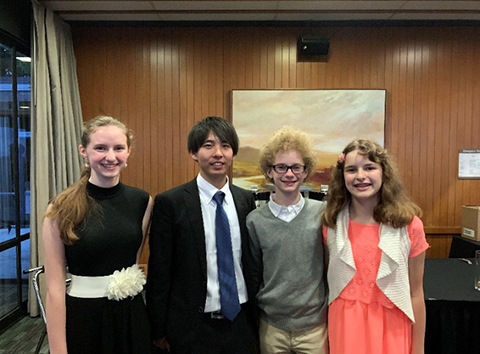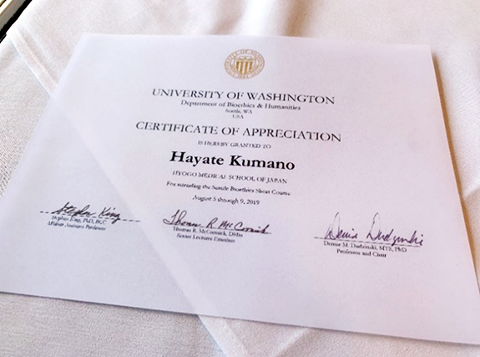国際・国内交流
熊野 颯さん(第5学年次)
ワシントン大学での研修を終えて
私は、今回8月3日から10日にかけてワシントン大学にて、生命倫理プログラムに参加させていただきました。このプログラムに参加しようと思ったきっかけは、今まで実習や座学で医学については学ぶ機会が多くありましたが、倫理について学ぶ機会はあまり多くはありませんでした。だからこそ、このプログラムに参加することによって、今後の医師生活に役立てたいと思い応募させて頂きました。
講義初日は、Clinical Ethics、Ethical Issues in Pediatrics、Ethical Issues in Genetics Palliative Care for Pediatric Patientsについての講義を受けました。中でも特に印象に残っているのはClinical Ethicsの講義の中で、McCormick先生がおっしゃっていた4 box methodについての講義でした。これは、今回の生命倫理の講義全ての芯にある考え方で、1.medical indication(医学的背景)、2.patient preference(患者の意向)、3.quality of life(生命の質)、4.contextual features(患者背景)の4つの枠組みに症例を当てはめていく考え方です。講義では、十二指腸閉鎖を伴ったダウン症の新生児の例でこの考え方を当てはめました。今回の例では、1には十二指腸閉鎖に対する手術、2には患者が小児なので自己決定ができず、両親が代理人であり両親は手術を拒否しているということ、3には手術をしないと脱水や栄養不良で亡くなるが、手術を行うとDown症の方と同じくらい生きることができること、4では時代や場所、社会的期待などがあげられます。今回の症例では、経済的にも両親は手術を拒否していますが、手術をしなければその小児は死んでしまうという倫理的問題に直面した時にどのように考えていくかを学びました。このように、それぞれの枠組みは重要視されていますが、4つを同等に考えていることは日本では馴染みがなく、アメリカ独自の自主性を重んじるからこそだと感じました。
そして、講義2日目は、朝からSeattle Cancer Care Allianceに行きました。そこではまずその施設がどのような構造になっているかの説明を受けました。そして、FRED HUTCHに行き、ノーベル賞を受賞された3人の説明や幹細胞移植をされた方たちの説明を受けました。その後、Elizabeth Loggers先生からMedical ethicsについての講義を受けました。この講義では、医療倫理にはNonmaleficence、Beneficence、Autonomy、Justiceの4つがあることや、医師のプロフェッショナルには、Expert knowledge、Act in the best interest of the patient、regulate themselvesの3つが必要であることを学びました。2限目には、Shallender先生から皮膚癌の免疫療法についての講義を受けました。この講義ではアメリカで5位の死亡率を占めている皮膚癌の治療がたくさん出てきており、新薬も次々と開発されているが、その反面、医療コストが上昇していること問題もあることを知りました。
3日目は、朝からNORTHWEST Kidney Centersに行きました。そこでは主に透析を行っており、1年間/1人、10,000ドルの費用がかかっています。しかし、透析にかかる費用は、75%がUS政府、15%が州政府、残りの10%が民間保険制度で支払っているところが日本と違うと感じました。また、King先生のSpiritualityの講義では、Chaplainの役割についての説明を受けました。日本では全く馴染みがありませんでしたが、この講義を通して、Chaplainは患者に対し暖かくサポートすることが一番大事であること、近くの人には相談できない悩みを聞いてあげたり、自分の人生にタイトルをつけるなら何になるかなど様々なサポート、ケアを行っていることを学ぶことができました。
4日目の講義最終日は、ワシントン大学にて尊厳死や、Family medicineなどについて学びました。尊厳死法はアメリカで投票によって決まったことや、尊厳死はアメリカの7州で認められていることを知ることができました。そしてFamily medicineの講義では、家庭医は出産から終末期まで診るという日本ではあまりないので珍しいと感じました。また、全人的に患者を診ているからこそ、様々な場面で倫理的な問題が存在することを意識することが大切であることを学ぶことができました。
また、この他にもスターバックス1号店や、スペースニードル、クルージング、PUBLIC MARKETなど勉強以外にも様々なところを訪れることができました。この1週間は勉強ももちろんですが、アメリカでの生活や現地の人々の習慣、街並みなど、何もかもが新鮮で、とても貴重な経験ができました。
最後になりましたが、今回のような素敵な機会を与えてくださった枚方療育園の山西先生をはじめ、関先生、蒲生先生ご夫妻、近藤先生、中村先生、枚方療育園の梅澤さん、櫻井さん、McCormick先生、King先生をはじめとするワシントン大学の先生方、ガイドのヨシコさん、通訳のTuridさん、ありがとうございました。

